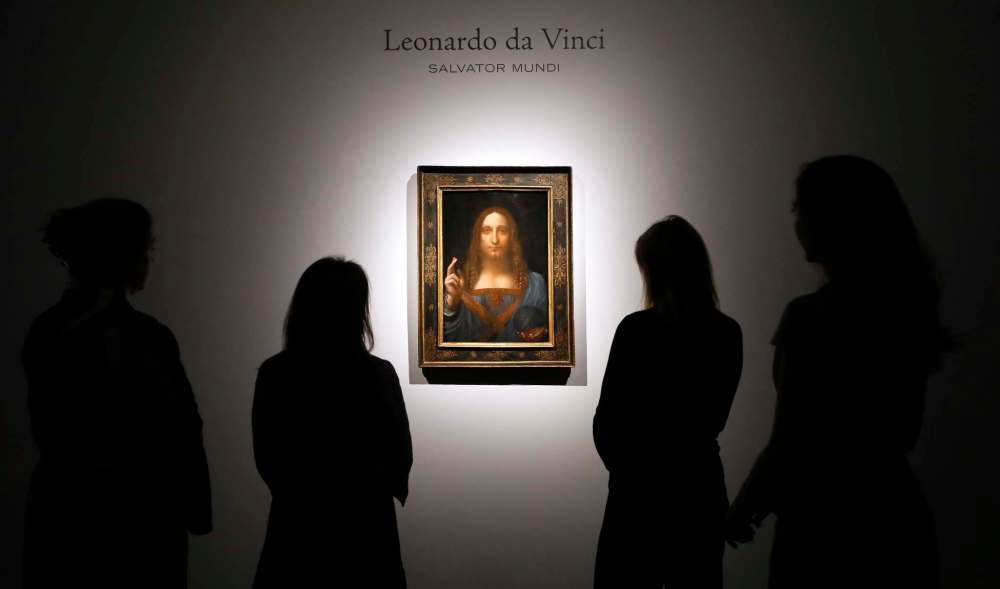Saudi prince revealed as buyer of da Vinci
Advertisement
Read this article for free:
or
Already have an account? Log in here »
To continue reading, please subscribe:
Monthly Digital Subscription
$1 per week for 24 weeks*
- Enjoy unlimited reading on winnipegfreepress.com
- Read the E-Edition, our digital replica newspaper
- Access News Break, our award-winning app
- Play interactive puzzles
*Billed as $4.00 plus GST every four weeks. After 24 weeks, price increases to the regular rate of $19.00 plus GST every four weeks. Offer available to new and qualified returning subscribers only. Cancel any time.
Monthly Digital Subscription
$4.75/week*
- Enjoy unlimited reading on winnipegfreepress.com
- Read the E-Edition, our digital replica newspaper
- Access News Break, our award-winning app
- Play interactive puzzles
*Billed as $19 plus GST every four weeks. Cancel any time.
To continue reading, please subscribe:
Add Winnipeg Free Press access to your Brandon Sun subscription for only
$1 for the first 4 weeks*
*$1 will be added to your next bill. After your 4 weeks access is complete your rate will increase by $0.00 a X percent off the regular rate.
Read unlimited articles for free today:
or
Already have an account? Log in here »
Hey there, time traveller!
This article was published 09/12/2017 (2835 days ago), so information in it may no longer be current.
When Leonardo da Vinci’s long-lost painting, Salvator Mundi (”Savior of the World”) shattered records by selling for US$450.3 million at auction in mid-November, its fate remained as mysterious as its unknown buyer. But both were revealed on Wednesday.
Museumgoers will be able to view the painting at the Louvre Abu Dhabi, a United Arab Emirates franchise of the Paris museum, Christie’s Auction House told Bloomberg. The museum appeared to confirm this, tweeting on Wednesday that, “Da Vinci’s Salvator Mundi is coming to #LouvreAbuDhabi.” It is unclear at this time when the painting will be displayed.
According to the New York Times, the painting’s buyer was not the museum but an outside party: one Prince Bader bin Abdullah bin Mohammed bin Farhan al-Saud, a “little-known” Saudi Arabian prince with no history as an art collector.

The Louvre Abu Dhabi, which opened on Nov. 11, has been one of the “most aggressive buyers on the global art market over the last decade,” according to Bloomberg.
These acquisitions, including that of Salvator Mundi, are probably part of a dedicated effort to raise the global cultural profile of the UAE.
Prince Bader’s purchase of the painting is surprising for a number of reasons, as the New York Times noted.
First, the painting portrays Jesus, whom many Muslims believe to be a prophet. Most who practise Islam — the state religion of Saudi Arabia — shun visual portrayals of its prophets.
When he placed the required US$100 million to participate in the Christie’s auction, lawyers from the auction house asked how he acquired the money, according to documents obtained by the Times.
He reportedly responded that it came from real estate and that he was one of 5,000 princes, saying nothing more.
Finally, the splashy purchase came just as Saudi Arabia’s 32-year-old crown prince, Mohammed bin Salman, was leading a “sweeping crackdown against corruption and self-enrichment” among the country’s elite, as the Times noted.
Salvator Mundi, which depicts Jesus holding a crystal orb in his left hand and raising his right in blessing, is one of some 16 known surviving works painted by da Vinci. While most are scattered around the world, the Louvre Abu Dhabi will now have two of these paintings. It displays La Belle Ferronnière, which is on loan from the Louvre in Paris, according to Bloomberg.
The painting disappeared several times over the course of history, most recently in 1958 when it was sold alongside the rest of the Cook Collection in London. By then, though, the painting’s origin had been obscured due to overpainting and it was credited to da Vinci’s follower Bernardino Luini. It sold for only 45 pounds or about US$125 today, CNN reported.
New York-based art collector and da Vinci expert Robert Simon and art dealer Alexander Parish found the painting in Louisiana in 2005 and purchased it for US$10,000.
It then underwent a six-year restoration and verification process.
In 2013, a consortium of dealers including Simon, Parish and Warren Adelson sold Salvator Mundi for US$80 million to a company owned by a Swiss businessman and art dealer Yves Bouvier, Bloomberg reported. Bouvier, in turn, sold it to Russian billionaire Dmitry Rybolovlev for US$127.5 million in 2014.
— Washington Post


